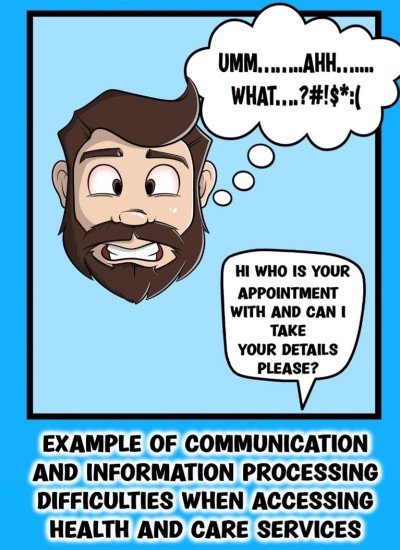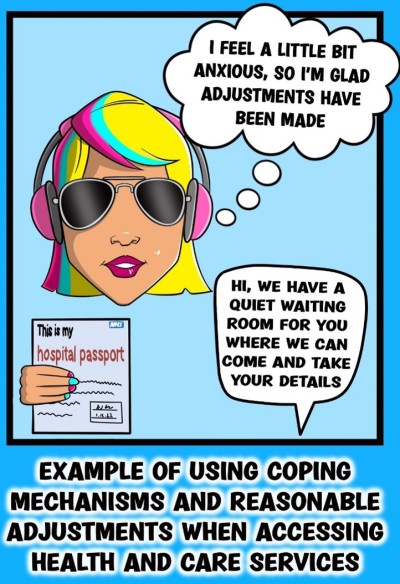Use the 'next' button to view the Autism Strategy page by page.
Aim four of our autism strategy is 'Tackling health and care inequalities for autistic people.'

In this section we have included examples by Autistic Minds to help illustrate communication and information processing difficulties when accessing health and care services.
Later in this section we discuss:
- Themes, feedback and suggestions raised by people during our review
- Our commitments to deliver this aim
- How we will work towards our aim within CWP between 2022-2027
- How we will work towards our aim with partners between 2022-2027
Artwork by Helen’s Artsy Creations
| Tackling health and care inequalities for autistic people | |
|
Example of communication and information processing difficulties when accessing health and care services.  "Hi who is your appointment with and can I take your details please?." |
Example of using coping mechanisms and reasonable adjustments when accessing health and care services:
 Thought bubble: "I feel a little bit anxious, so I'm glad adjustments have been made." |
|
Rupert has gone for a health service appointment, he feels anxious and overwhelmed. This means he cannot process information or communicate his needs effectively.
He is unable to provide the information the receptionist is asking for and wishes he brought his partner Jeff along to help. |
Tatiana brought her hospital passport to her appointment which provides all of her information, so the health professional is able to quickly make adjustments for her. Tatiana has also brought her mum along for support. |
|
Themes, feedback and suggestions raised by people during our review: |
|
Quality of service provision and delivery Barriers to accessing support
Post-diagnostic support
Person-centred care Health and care inequalities experienced by autistic people are different depending on the individual and their presentation. For example, people with autism-only may experience different access/ care support issues to those with autism and ADHD, or autism and an intellectual disability. Autistic people, and those who identify as autistic, need services to flex their approach to their individual needs. Working with partners and stakeholders Individuals, families and carers described difficulty in finding out what services are available and how to access them.
|
|
Our Commitments to deliver this Aim |
|
Workforce development Please refer to our commitments under Aim 1: improving understanding and acceptance of autism within society. Quality of Service Provision and Delivery With the support of commissioners, we will ensure that people receive a high quality and timely diagnosis to help them better understand their needs and therefore be able to access and get the right support. We will understand the wants and needs of the individual autistic people we support through active listening. The health and care we deliver will use the appropriate reasonable adjustments to meet the person-centred needs of the individuals it is supporting. This includes investment in our environment (community and inpatient) to be more autism friendly. We will continue to support and drive research into autism through CANDDID using our stakeholder conference to identify the key areas of research people want us to work on. We will ensure we are both sighted on and learn from the NHS England and NHS Improvement ‘Learning from Lives and Deaths - People with a Learning Disability and Autistic People Programme’ (LeDeR). Working with partners and stakeholders We will work with commissioners to improve access times for diagnosis (all ages), as well as secure investment to further develop pre-diagnostic and post-diagnostic support. For people accessing our services, we will aim to identify and highlight any physical health issues, working with our partners in primary and secondary care services to address these promptly, thereby improving health outcomes. We will work with our GP Practices to pilot the use of the Annual Health Check for autistic people. We will work with our partners in local community services (Local Authority, GP Practices and 3rd sector) to help identify and signpost autistic people accessing our services to the wider support available, based on their individual wants and needs. |
How we will work towards our aim within CWP between 2022-2027:
Quality of Service Provision and Delivery
Improving people’s experience of care and their outcomes
Through our Trust-wide Neurodevelopmental Disorder Clinical Network Group, we will develop our autism offer across all services, based on needs and supported by a thorough initial assessment and diagnostic formulation based on a profile of strengths and needs (as recommended by the National Institute of Clinical Effectiveness).
We will improve our data collection on diagnosis so that we can better track waiting times, access and outcomes for autistic people alongside the same measures for all people. Our outcome measures will look at quality of life impacts.
Where additional investment is made, we will work to ensure best use of additional resource – based on an assessment of the gaps in the current all age offer and the experiences of autistic people accessing our services.
We will ensure that the Green Light Toolkit approach is used to create person-centred
care plans for autistic people accessing services. This will be supported by our workforce skills actions (see Aim 1).
In services for children and young people, we will review the interface between different services (for example, the mental health offer, support for youth justice offer, intellectual disability offer) and develop a set of principles and support offer which will improve the pathway experience for young people and their families.
We will continue to develop an autism friendly environment across our inpatient and community sites, with an initial focus on inpatient areas with high use by autistic people. We will use the National team for Inclusion (NDTi) guidance Its Not Rocket Science to help inform this work.
We will continue our work through CANDDID to undertake research into autism. Current projects include the Autism Diagnostic Aid (ADA) project. The ADA tool was developed based on the diagnostic criteria for autism as described in the ICD-10 (the World Health Organisations’ International Classification of Diseases, 10th series). This research project is now focussing on the validation of the ADA tool as a diagnostic tool for autism in people with intellectual disabilities.
How we will work towards our aim with partners between 2022-2027:
Working with partners and stakeholders
We will continue to highlight the long waiting times faced by autistic people (all ages) to commissioners at a local, regional and national level as well as the need for recurrent funding for post-diagnostic support.
Our Aim 1 work to enhance the on-line access to training for family members and unpaid carers (free to access) will help to support people as they wait for a diagnosis.
We will continue to link with local services and support groups so that our teams are well-informed about the services autistic people can access out in the community, and communities know about the support we can provide.
We will look carefully at any potential for underlying physical health issues in the autistic people we support, accessing appropriate health and care with partners to resolve these. As part of this work, we will work with our GP Practices to pilot the Annual Health Check for autistic people.
We will work with partners to ensure that any young autistic people who are not currently accessing mental health care services as they turn 18, are able to be signposted so that support can be provided at this crucial time (which is often called transition). We are aware that this time when the service offer changes is one where young people and their families often struggle.
We will continue to work with our partners to support individual Learning from Death reviews, as well as receive and act upon learning identified regionally and nationally.